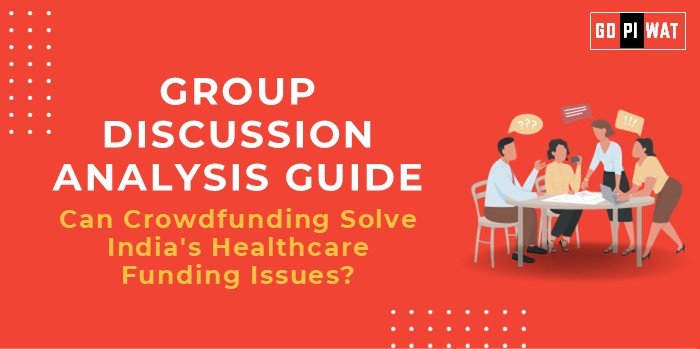📋 Group Discussion Analysis Guide: Can Crowdfunding Solve India’s Healthcare Funding Issues?
🌐 Introduction to the Topic
- 💡 Opening Context: India’s healthcare system faces significant funding challenges, especially in rural and underserved areas. Crowdfunding has emerged as a tool to mobilize small contributions for individual healthcare needs or public health projects, raising hopes for addressing funding gaps.
- 📜 Topic Background: Crowdfunding in India gained traction with platforms like Milaap and Ketto, enabling citizens to contribute directly to causes. Globally, it has funded innovative treatments, emergency care, and community health projects.
📊 Quick Facts and Key Statistics
- 📉 India’s Healthcare Expenditure: 3% of GDP in 2023—among the lowest globally.
- 💵 Crowdfunding Market Size: Expected to reach $20 billion by 2025 in India.
- ✅ Platform Success Rates: Ketto reports funding 60,000+ healthcare campaigns in 2022.
- ⚕️ Treatment Cost Gaps: 63% of Indians face out-of-pocket expenses for healthcare.
👥 Stakeholders and Their Roles
- 🌐 Crowdfunding Platforms: Provide the technology and reach to raise funds.
- 🏛️ Government: Regulates platforms and provides supplemental funding in key areas.
- 🤝 NGOs: Collaborate on campaigns for transparency and impact.
- 👥 Citizens: Contribute funds and benefit from lower-cost healthcare access.
- 🏢 Corporate Donors: Leverage CSR initiatives to boost healthcare campaigns.
🏆 Achievements and Challenges
✨ Achievements
- 🏥 Access to Funds: Enabled low-income families to afford critical care.
- 📢 Awareness: Increased public understanding of healthcare needs.
- 🌍 Global Case Success: In the U.S., platforms like GoFundMe raised over $3 billion for medical expenses in 2021.
⚠️ Challenges
- 🔄 Sustainability: Relies on individual donations, which may not meet large-scale needs.
- ⚖️ Equity Issues: Urban and tech-savvy individuals benefit more than rural citizens.
- 🔍 Transparency: Concerns over fund misuse or inefficient distribution.
💬 Structured Arguments for Discussion
- 💪 Supporting Stance: Crowdfunding democratizes healthcare funding, making life-saving treatments accessible to underserved populations.
- ⚖️ Opposing Stance: Over-reliance on crowdfunding shifts the burden from systemic reforms to individual donations.
- 🤝 Balanced Perspective: While crowdfunding provides immediate relief, it cannot replace comprehensive policy solutions for healthcare funding.
📚 Effective Discussion Approaches
- 💡 Opening Approaches:
- 📊 Start with a data point: “India spends only 3% of GDP on healthcare, one of the lowest among major economies.”
- 📚 Use a case study: “In 2021, a crowdfunding campaign on Milaap saved a newborn requiring urgent heart surgery.”
- 🤔 Counter-Argument Handling: Emphasize systemic reforms as complementary, not competing solutions.
🔎 Strategic Analysis of Strengths and Weaknesses
- 💪 Strengths:
- 🌐 Mobilizes diverse contributors.
- 🏥 Supports urgent, personalized campaigns.
- 🛑 Weaknesses:
- 🌍 Coverage limited to connected populations.
- ⚖️ Lack of regulatory frameworks.
- 🌟 Opportunities:
- 🤝 Integration with CSR and public health policies.
- 🤖 Use of AI for campaign targeting.
- ⚠️ Threats:
- ⚠️ Fraudulent campaigns eroding trust.
- 📉 Dependence on economic stability.
🎓 Connecting with B-School Applications
- 📊 Real-World Applications: Crowdfunding insights can drive innovations in microfinance or health insurance models for MBA projects.
- ❓ Sample Interview Questions:
- 💡 “Can crowdfunding bridge the urban-rural healthcare gap in India?”
- 📈 “How would you scale a successful crowdfunding healthcare campaign?”
- 📝 Insights for B-School Students: Crowdfunding illustrates grassroots innovation and collaboration, useful for understanding social impact financing.


